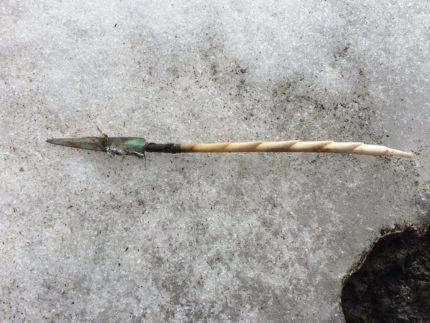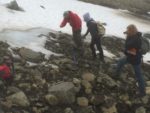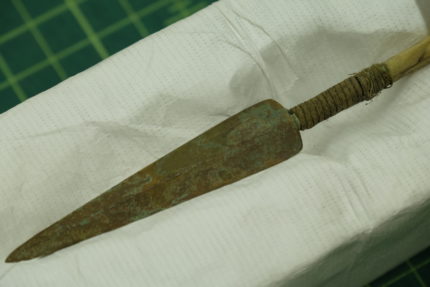A wicked looking copper arrowhead still masterfully attached to a barbed antler shaft discovered in a melting patch of ice in Yukon, Canada’s northwestern most province, in 2016 has been found to be almost 1,000 years old making it one of the earliest copper artifacts ever found in the Territory.

The credit for this discovery goes to a herd of caribou, because even though the arrowhead was found by an archaeologist, he wasn’t at the site to excavate or search for ancient artifacts. Archeologist Greg Hare was flying over the area in a helicopter accompanied by a film crew that was shooting a documentary. He was pointing out some of the sites where he and his colleagues have discovered First Nations hunting weapons when they saw the caribou. The documentarians wanted to get a clean shot of the majestic ruminants so Hare’s helicopter landed to allow the filmmakers in the second copter to get a clean shot.
 The rocky hillside where they landed was topped with a rapidly vanishing layer of half-melted ice and under normal circumstances they would never have stopped there given the precariousness of the melting ice on the surface. While they were waiting, the team spotted a barb sticking out of a barely-there thin layer of ice. They pulled it out gingerly and found a copper blade attached to the barb.
The rocky hillside where they landed was topped with a rapidly vanishing layer of half-melted ice and under normal circumstances they would never have stopped there given the precariousness of the melting ice on the surface. While they were waiting, the team spotted a barb sticking out of a barely-there thin layer of ice. They pulled it out gingerly and found a copper blade attached to the barb.
“This is one of the oldest copper elements that we ever found in the Yukon,” Hare said.
For thousands of years, caribou took refuge in the summer up high on the alpine ice patches to escape the heat and swarms of harassing insects. That made those ice patches good areas for ancient hunters to get close to the caribou.
Some weapons would miss their marks and disappear in the snow and ice, over time building a treasure trove of artifacts now revealed by the melting ice. Archaeologists have found ancient hunting tools made of wood, antler bone, and now copper.
“The significant part of the story is that [the arrowhead] is so old, and it is such a beautiful expression of copper metallurgy,” Hare said. “Copper only first shows up in the Yukon about a thousand years ago and this is almost at the beginning of that technology.”
![]() The arrowhead was radiocarbon dated to 936 years ago. Bows and arrows only began to be used by First Nation hunters about 1,100 years ago, so this really is an incredibly early example of copper metallurgy in the area. For thousands of years before then the weapons of choice were atlatli, throwing darts launched by striking them with a paddle. It was a technology that was employed by indigenous peoples in Yukon for almost 7,000 years before it was abandoned in favor of the bow and arrow.
The arrowhead was radiocarbon dated to 936 years ago. Bows and arrows only began to be used by First Nation hunters about 1,100 years ago, so this really is an incredibly early example of copper metallurgy in the area. For thousands of years before then the weapons of choice were atlatli, throwing darts launched by striking them with a paddle. It was a technology that was employed by indigenous peoples in Yukon for almost 7,000 years before it was abandoned in favor of the bow and arrow.
The copper in the arrowhead is incredibly pure at 99.9 percent, and it is of local extraction. The nugget from which it was made was recovered in the metal-rich creeks of the southwest Yukon. The quality of workmanship is exceptional and the hunter who missed his target doubtless would have searched for it in the snow and ice-covered terrain for days, even weeks, after it was lost.
The random good luck that put Hare and his team down on that hillside to recover such a rare and important transitional in the evolution of indigenous hunting weaponry would have passed them (and us) by if the timing had been only slightly off. Two weeks after the discovery, Hare returned to the site to explore it further and all the ice had melted leaving nothing behind to find besides lumps of still-frozen caribou dung. If there was anything there, it was carried away by the runoff into the rocks or down the hill.
Look at the condition of this arrowhead. It is a spectacular piece of work and we are very fortunate the right people were in the right place at the right time to rescue it in such pristine condition just as it emerged from the melt.
